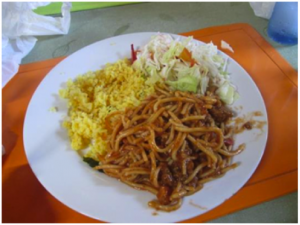Here it is, the final day of the trip! Most of the day was spent touring around and shopping around the touristy El Conde, the pedestrian-only street lined by shops and more cheap canvas paintings than you can count.
We started the day by heading past the Puerta del Conde, the location where Francisco del Rosario Sánchez supposedly declared independence from Haitian occupation in 1844. We then walked down El Conde (which was much busier than last night, as expected) to the Catedral Primada de America, which directly translates to First Cathedral of America. Unfortunately, the cathedral wasn’t open yet, so we headed over to a nice little art shop with all sorts of metallurgy, tile paintings, canvas work, and more. I picked up a nice tile painting of a typical Dominican man riding an overloaded motorcycle.

Puerta del Conde
After picking up some artwork to take home, we walked over to the Fortaleza Ozama, a very typical 16th century fortress which guards the mouth of the Ozama River to the Caribbean Sea. It is a small, tall, and sturdy castle which has been occupied by seven different countries and most recently served as a prison until opened to tourists in the late 20th century. While there wasn’t anything inside the castle, we got some beautiful group pictures with the Dominican Flag on top of the castle.

Fortaleza Ozama
Walking further along Calle las Damas, America’s oldest paved street, we took a tour of Museo de Las Casas Reales, an administrative building which served as a government office from the time of Spanish colonization until the 1970s. We had a very good Spanish tour-guide who called us out on our exhaustion, but cracked a few jokes to keep the tour fun. As we were looking at a map of Christopher Columbus’s voyages, he joked that Columbus always stopped in the Canary Islands to visit his girlfriend there. Later in a room with old medical equipment, he told us that any volunteers could have a free enema from their ancient device. For me, highlights of the museum included Trujillo’s weapon collection, which included strange combinations like a pistol-sabre and a crossbow-rifle. The ballroom was also a very beautiful and impressive room, decorated with large paintings and large glass chandeliers.

Las Casas Reales ballroom
We took a break to grab lunch at a very Caribbean buffet-style restaurant. Like many of our dining experiences this week, we were one of the only groups in the restaurant at 1:00. I’m not sure if this is because we were late to lunch, the restaurant isn’t popular, or both, but it’s never a bad thing to have the place to ourselves. I ate yellow rice, Dominican spaghetti, salad, and some small cake cubes. We had a cat sleeping above our heads, and until it moved in its sleep, we thought it was dead, which didn’t help our appetites. It must be a heavy sleeper, because it didn’t react when Camilo touched the tail. I also captured a significant amount of blackmail pictures on the camera, which can always come in handy.

Dominican spaghetti!
After lunch, we stopped by a specialty chocolate store, but very few people walked away with any chocolate because of the expensive prices that come with nice chocolate. The group split a little at this point, with a few people heading back to the art store while everyone else visited the Catedral Primada. After the girls with short skirts and Camilo covered their knees with blankets, we absorbed the atmosphere, both the Gothic and Baroque architecture and the very crisp and refreshing temperature, thanks to some great air-conditioning.

- Catedral Primada
And then the shopping commenced. I think most everyone had their share of bargaining: Nick replaced his pair of sunglasses he gave away, Kisha picked up two canvasses and some bracelets with Alex, I got an artsy wooden plate, Juli found a nice sombrero, and more. Kisha demonstrated her experience and persuasion by bargaining from 500 pesos per canvas down to 550 pesos for two. Obviously they start their prices high in order to make a large profit on unaware tourists, but cutting the asking price by almost half isn’t easy by anyone’s standards. I talked with Kisha after this feat and asked her about the morality and necessity of bargaining with these merchants. Is it morally right and is it financially worthwhile to negotiate over 50 pesos, a little over 1 USD? Is it healthy for their economy to bargain with them? These kinds of questions are difficult to answer, but between the two of us, we agreed that these “tourist” goods are likely obtained in bulk for a very cheap price, so even after being bargained down, they’re still making a large profit. The system is difficult to understand because it’s so much more difficult than our own; bargaining is very rarely a part of the American consumer market, where prices and profit margins are generally non-negotiable. In the Dominican Republic, bargaining is a perfectly normal part of street selling. Our presence and willingness to buy is what allows the tourism industry to thrive; individual negotiations play a small role from the grand perspective.

Kisha and Alex negotiating
Perspective is a very important concept for being internationally-aware, and enhancing our awareness was a large part of this trip. We dedicated much more time on this trip towards learning about and understanding the economic climate, Haitian relations, and educational system than we did directly assisting Yspaniola because our attitudes and awareness of the situation in the Dominican Republic is much more important than any number of flashcards we could have created in that time. There are many distinct levels of economic status on the island of Hispaniola, and it’s often shocking to compare them amongst themselves and then to our American lifestyle.
Let me break it down with a simple example: showers. On the Haitian side of the border in Dajabon, we saw children bathing in an unclean river. In Batey Libertad, almost everyone bathes by pouring buckets of water over their heads after the water is pumped down from the mountains. In the city of Santo Domingo, they shower in low-pressure cold or lukewarm water, if the water is turned on that day. Even in the Santo Domingo airport, there are no water fountains because the tap water is never safe to drink. To us, access to clean tap water is an assumed amenity, but for the Batey, any kind of running water would drastically improve their quality of life. We were not only humbled by our quality of life, but even embarrassed at how little we think about how much water we actually use and how much less the people of Hispaniola have, just a few hours from anywhere in the United States. For every day we wake up, take a shower, eat breakfast, and head to class or work, they go through the same process at basically the same time, but in very different conditions. Our lives are more connected and similar than we would think, yet a few miles of ocean separate our two worlds. It’s mind-boggling to think that, during any given evening, there are people in the Batey sitting without electricity and without running water, playing cards by candlelight where I once sat. For me, the people of the Batey will always be a reminder that it’s possible to live a happy and fulfilling lifestyle with or without wealth; it all depends on your mindset and willingness to be happy.
~Tim West, 2016










